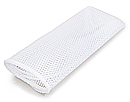Dishwashing Steps
There are better and worse ways to do the dishwashing. Even something as simple as what order you wash stuff in can make a huge difference.
1. Scrape off food residues into the garbage and empty cups before filling the sinks. Give really dirty plates and pots a quick rinse with warm water and the dish brush.
2. Rinse the dish brush and sinks quickly, and fill both sinks 2/3 full with water that is as hot as you can stand it. If you use rubber gloves you will likely be able to tolerate hotter water.
3. If your dish drainer is to the right, put a capful of regular dish detergent in the sink furthest on the left. Then put about 1/4 cup of white vinegar in your rinse water. You need to be able to move every item logically from wash to rinse to dry.
4. Start with the glasses and mugs. With your dish cloth, wash each one, making sure that you clean around the rim, and the exterior. If your mugs have coffee or tea residue inside, put a little baking soda on your dish cloth, rub lightly, and the marks should disappear with very little effort. Rinse in the vinegar water and place to drip dry.
|
5. Next, put the cutlery in the bottom of the sink (no sharp knives!) It can soak there while you clean the bowls and plates. |
 |
Clean the plates - remove any visible residues with the dish brush and give a wipe with a dishcloth to eliminate smaller stuff that you can't see so easily. Rinse and place in drainer tray or on towel.
6. The cutlery should have had a nice soak by now, so pick up and clean a couple of pieces at a time with the dish cloth.
7. Pick up any sharp objects from the counter and wash them carefully one at a time. Don't put them in the sink where you won't be able to see them!
8. Check your wash water. How dirty is it? If it looks gross - change it now, or you won't be able to get the serving platters and pots and pans clean.
9. Take a look at what is left in the dirty pile. Work starting with the cleanest and moving to the dirtiest items. This will keep your water in good shape as long as possible.
10. Wash each item, using the brush and cloth in most cases. It the food residue is really stuck, you may need to use your scouring pad. If you do - use it in lots of water so that your dishes don't get scratched!
11. Once you're done, rinse your brush, scouring pad and dish cloth in the vinegar water.
12. Take the cloth and wipe down all the counter tops. Rinse again, squeeze out and dry. If your cloth is a high-quality microfiber, you don't need soap. If it isn't, you will want to use a little dish detergent on the cloth. Rinse the counters with water and a little vinegar water if you used soap.
Why All the Fuss About Having an Order, and Trying to Keep the Water Clean?
Of course dishwashing gets the water dirty! That's normal, however it is important to keep the water as clean as possible for as long as possible and here's why...
Soap is a chemical, and we use it to make our dishwashing easier by reducing the amount of scrubbing we have to do. However, like all chemicals, it's a bit fussy. The more muck is hanging around in the water, the harder it is for the soap to work properly and grab onto dirt - and there reaches a point where it becomes likely that dirt and food residue will start to stick to your hands and to be transferred back to the dishes. I don't know about you, but when I'm washing dishes I prefer the dirt to go down the drain.
To prevent or reduce this problem, it's a good idea to wash from the cleanest to dirtiest.
Back to Washing Dishes
from Dishwashing Steps
